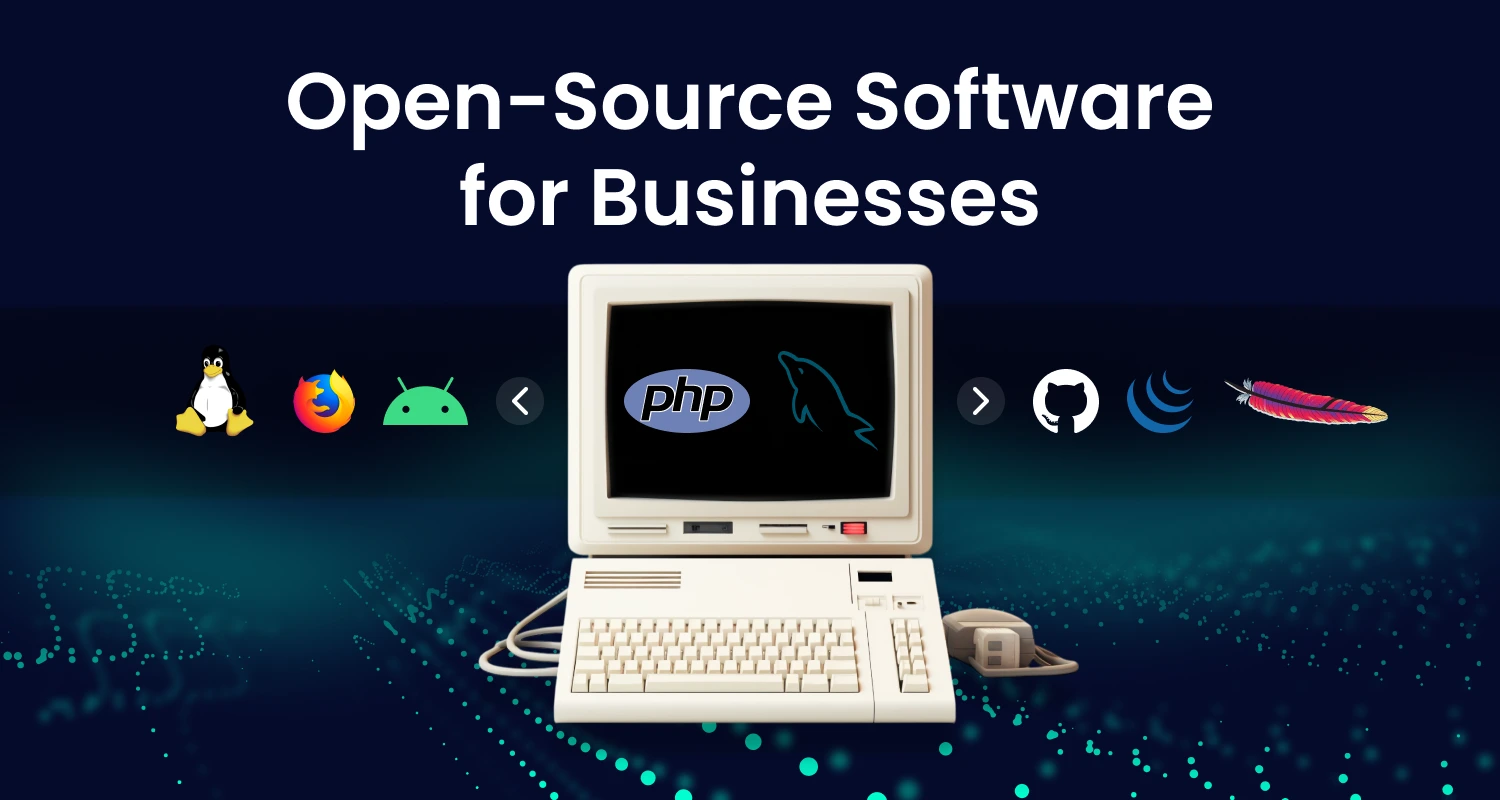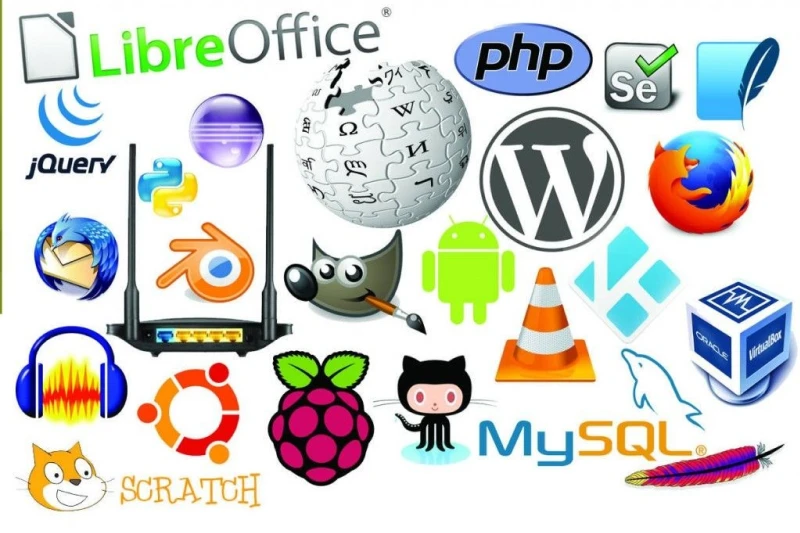
When evaluating open-source software, a business must carefully consider the pros and cons of open-source software. At the same time, the appeal of affordable, highly customizable options like Linux and WordPress is compelling; it’s equally vital to assess potential security risks and the accessibility of reliable support.
This thorough approach ensures informed decisions, strategic adoption, and sustainable growth.
1. What is open-source software?
Open-source software refers to software whose source code is accessible for anyone to examine, alter, and share without charge. Unlike proprietary software, where the source code is locked and controlled by a company, open-source software encourages collaboration, transparency, and innovation.
Some well-known open-source software examples include Linux, Apache, MySQL, WordPress, GitHub, and Firefox. Thanks to its cost savings, flexibility, and security benefits, businesses increasingly use open-source software for business needs.
However, while the pros of open-source software are compelling, there are also challenges to consider. This article will explore the pros and cons of open-source software, helping businesses decide if it’s the right choice for them.

Read more >>> What is Outsource Company? Top Reasons to Outsource Services
2. Pros of open-source software
The allure of open-source software stems from its multifaceted advantages, each contributing to a compelling value proposition for businesses. Let’s delve into the core benefits that make it an increasingly attractive option.
2.1. Cost efficiency and affordability
One of the most significant open-source software advantages is its free use. Unlike proprietary software, which requires expensive licensing fees, open-source solutions offer substantial savings. Businesses can cut costs on software acquisition, reducing their overall expenses.
- No licensing fees: Open-source software does not require costly per-user or per-device licensing.
- Lower total cost of ownership: Businesses save money not just on the software itself but also on long-term maintenance.
- Budget flexibility: Companies can allocate resources like customer support or product development elsewhere.
The financial aspects highlighted here are essential to any discussion regarding the advantages and disadvantages of open-source software.
2.2. Flexibility and customization
The benefits of using open-source software in business include tailoring the software to meet specific needs. Unlike proprietary software, which offers limited customization, open-source software allows businesses to modify and optimize the code for their operations.
- Modify source code: Businesses can adapt features to match their workflow.
- Tailor-made solutions: Instead of being locked into a one-size-fits-all system, companies can create a unique software experience.
- Greater control: Open-source solutions allow complete control over updates and customizations.
2.3. Security and transparency
Understanding both the open source software advantages and potential security considerations is crucial. Security should always be at the forefront of our considerations when selecting software.
Unlike closed-source systems, where vulnerabilities can remain undetected for long periods, open-source projects undergo continuous and rigorous examination. This ongoing scrutiny significantly enhances security, providing users with greater confidence in the software they rely on.
- Open access to source code: Developers worldwide inspect and enhance security features.
- Faster detection and fixing of vulnerabilities: Bugs are identified and resolved quickly.
- Enhanced trust and reliability: Transparency ensures businesses know what is happening behind the scenes.

2.4. Community and support
One of the open-source software advantages is the vibrant developer community that surrounds it. This community offers comprehensive documentation, fosters active support forums, and ensures consistent updates, making it easier for users to thrive and innovate.
- Access to expert developers: Many experienced programmers contribute to the development and improvement of the software.
- Online support forums: Active communities help troubleshoot issues and offer solutions.
- Frequent updates: Continuous development ensures long-term usability.
2.5. Innovation and continuous improvement
Why businesses should use open-source software often comes down to innovation. With a global community of developers contributing new features, open-source software evolves rapidly.
- Regular updates and improvements: New functionalities and security patches are continuously added.
- Encourages technological advancements: Businesses can take advantage of cutting-edge features before they become mainstream.
- No vendor lock-in: Companies are not restricted to a single provider, giving them greater flexibility.
Looking for a Tech Partner Who Delivers Real Results?
We provide tailored IT solutions designed to fuel your success. Let`s map out a winning strategy. Starting with a free consultation.
Connect with an ExpertRead more >>> Offshore BPO Outsourcing: A Game-Changer for Cost-Effective Operations
3. Cons of open-source software
While the advantages of open-source software are undeniable, it’s crucial to acknowledge the potential challenges that businesses may encounter. A balanced perspective requires a candid look at the drawbacks.
3.1. Limited professional support
One of the most significant disadvantages of open-source software is the lack of guaranteed customer support. Unlike proprietary software, which offers dedicated technical assistance, businesses using open-source tools may need to rely on community forums and independent developers.
- No dedicated helpdesk: Companies may struggle with troubleshooting urgent issues.
- Dependence on third-party consultants: Some businesses may need experts to manage their software.

3.2. Compatibility and integration issues
To fully understand the pros and cons of open-source software, while open-source software offers flexibility, integrating existing systems can sometimes be challenging. Open-source software vs proprietary software often comes down to how well the solution integrates with other tools.
- Challenges with proprietary software integration: Some open-source tools may not work seamlessly with closed-source solutions.
- Potential lack of standardization: Different versions and forks can lead to inconsistencies.
3.3. Steep learning curve
Specific open-source tools for business require technical expertise to implement and maintain. Businesses without in-house IT teams may find it challenging to adopt these solutions.
- Complex setup process: Initial implementation may require advanced technical knowledge.
- Employee training required: Staff may need to learn new workflows and commands.
- Ongoing maintenance: Businesses must ensure the software remains updated and secure.
3.4. Potential for fragmentation
Since open-source software is freely available, multiple variations, or “forks,” may exist. This can create inconsistencies, making it harder for businesses to choose the best version.
- Different versions may lack standardization: Not all versions receive updates simultaneously.
- Difficulties in finding the right software fork: Businesses must research the most stable version for their needs.
3.5. Hidden costs and maintenance
While open-source software is free, hidden costs can arise when considering customization, maintenance, and support.
- IT staffing costs: Companies may need to hire or train IT personnel.
- Security and compliance expenses: Ensuring the software is secure and compliant requires resources.
- Regular updates and patches: Keeping software up to date requires ongoing investment.
A comprehensive analysis of the open-source software pros and cons for businesses must include an evaluation of potential hidden costs and maintenance requirements.
Read more >>> Software In-House vs Outsourcing: What’s the Right Choice?
4. How open-source software benefits businesses
Beyond the individual advantages and disadvantages, it’s crucial to understand the broader impact of open-source software on business operations. Explore how it can drive tangible benefits and strategic advantages.
4.1. Increased business agility
One of the key benefits of open-source software for business is increased agility. Open-source software empowers businesses to be highly agile and responsive to evolving market demands.
With rapid software deployment capabilities, organizations can implement new features swiftly, keeping them ahead of competitors.
Moreover, efficient scaling means that businesses can grow seamlessly without the burden of costly software upgrades. This flexibility saves money and positions companies for sustained success in a fast-paced environment.
4.2. Customizability for specific business needs
Unlike standard proprietary software, open-source solutions empower businesses to customize features to fit their unique workflows perfectly.
With personalized functionality, companies can create tailored solutions that meet their exact needs.
Additionally, this flexibility ensures that the software can evolve with the company’s growth, aligning seamlessly with business objectives. Embrace open-source for a more dynamic and responsive approach to your software needs.
4.3. Scalability and growth
As enterprises experience growth, they increasingly adopt scalable solutions. Open-source software provides the flexibility to expand without the burden of costly upgrades.
Organizations can thrive without the constraints of significant financial investment by eliminating expensive licensing tiers. This software seamlessly adapts to increased workloads, enabling companies to address their software requirements without limitations.
4.4. Lower total cost of ownership
While maintaining open-source software is necessary, the overall cost savings compared to proprietary alternatives are considerable. Over the long term, these financial benefits contribute to a significant reduction in software expenses.
Furthermore, open-source solutions typically entail minimal upgrade fees, thus eliminating the burden of expensive version upgrades.
5. Conclusion
The pros and cons of open-source software highlight its potential as a powerful business tool. While it offers cost savings, flexibility, and security, businesses must consider challenges like support limitations and compatibility issues.
For companies that require customization, scalability, and control over their software, open-source alternatives provide a compelling choice. However, those seeking plug-and-play solutions with dedicated support may find proprietary software more suitable.
Ultimately, the best decision relies on the specific requirements of your business. Open-source software can be a beneficial resource when used thoughtfully, whether you’re a startup seeking to reduce expenses or a corporation pursuing more significant innovation.




